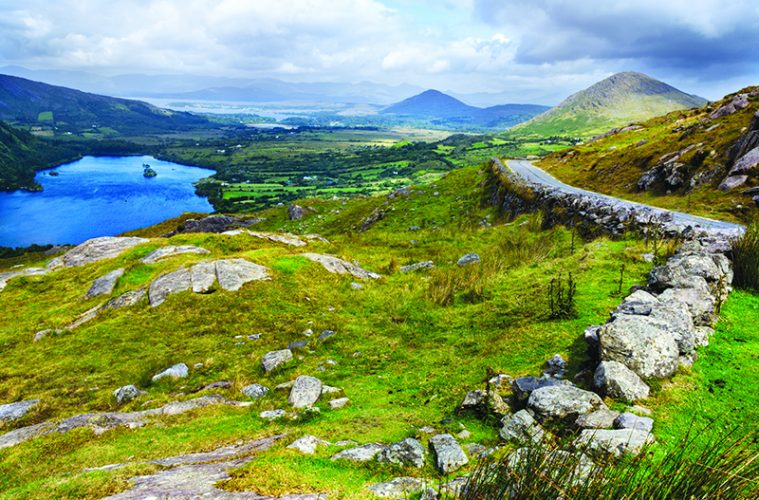People warn you about the narrow roads, the tight turns, the sheep wandering out in front of your car. And, of course, there’s the additional challenge of driving on the left. But somehow, no one thinks to mention the 10-foot hedges that line both sides of most Irish highways, eliminating your ability to see around the famous bends and leaving you nowhere to go if you should need to suddenly jerk away from one of the many 18-wheelers laying claim to both lanes.
This is day five of our two-week trip, and it turns out that today has more in store than a safe drive. We don’t yet know it, but this will be one of the best days of our trip: a day when, as the Irish say, the road will rise up to meet us and the wind will be at our backs. It’s a day when little accidents of luck will line up to create a series of small, beautiful moments.
In the morning, we start out from our temporary base in Kilkenny, a medieval town in the southeast of Ireland, where a grand 12th-century castle sits just across the river from our hotel. The sky is blue and full of fluffy, low-lying white clouds, but they do nothing to obscure the sun, which lights up the countryside in a kaleidoscope of green.
We’ve planned our first stop, the ruins of Kells Priory, but nothing beyond that. When we pull up to the ruins of the 12th-century monastic site, we’re all alone, save for the dozens of grazing sheep that foreground the stone structures, and a vista of rolling green hills unfolds in the distance. It’s the exact Ireland we’d imagined when we planned the trip, and we snap a few quick photos and then step inside the postcard.
A little pamphlet purchased from an honor box tells us a bit about the site’s past, how the walls between the tower houses were designed to stand up to raids, and how the countless vertical slits between the stones protected archers. I briefly try to imagine a world in which monks are forced to take breaks from their prayers in order to shoot their enemies full of arrows; but in truth, I’m more enamored by the present—by the sight of my barely toddling one-year-old daughter attempting to negotiate the hilly terrain while holding my wife’s hand, and the sounds of my four-year-old son turning the ruins into his own personal playhouse.
We pile into the rental car and drive east until we reach Thomastown, a little village that merits a brief mention in our guidebook, but where we appear to be the only visitors. Our lone bit of criteria in choosing a restaurant is that it serves “goujons” (the Irish term for chicken nuggets, we’ve quickly learned), but this quest is unsuccessful, so instead we duck into Café Sol, where my son is content to order four slices of bacon, à la carte.
The weather is holding up, allowing the restaurant to live up to its name, and we dine on a sun-filled patio decorated with hanging flowerpots and a mural of a freshly tilled field lined with sunflowers. My wife orders a salad, I order a steak sandwich, and soon we’re chatting with a trio of Irish women who are taking what appears to be an extremely languid lunch break from their jobs.
One of the great pleasures of visiting Ireland is talking to the people, who tell you at every chance how “lovely” and “brilliant” you are, until you start to believe it yourself. These women are no exception. On our itinerary: “Brilliant!” On our children: “So lovely.” On my decision to order a steak sandwich: “Well, now, that’s just lovely and brilliant, isn’t it?”
Following the women’s recommendation, we next drive 20 minutes to the Woodstock Gardens & Arboretum, where we let the kids swing and slide at the playground and then amble for a long while among strange trees like the monkey puzzle, which looks like a surreal twist of prickly green pipe cleaners. At the end of our walk—although he is nearing exhaustion—my son invites himself to play soccer with a group of boys twice his age. He has no idea how to play, but they don’t seem to mind him chasing them around, squealing with delight and falling on the ground in imitation of their dives. When I tell him to try to kick the ball, he says, “But the other boy is playing with it.” Behind this scene is a valley landscape so sprawling and pretty that it looks like a painted backdrop.
Our trip will be full of once-in-a-lifetime sights and experiences, from the Guinness Brewery to Killarney National Park. But it’s these sorts of moments that we did not plan—that we could not plan—that I know will stay with me the longest.
We drive back to Kilkenny the long way, not wanting to backtrack, and by the time we stop in the unpronounceable village of Graiguenamanagh for a “99” (a soft-serve ice cream cone with a bit of flaky chocolate bar stuck in it), the clouds threaten for a moment to finally overtake the tired sun. But then the sunlight breaks through again, in a cinematic burst of individual rays.
“Wow,” my wife says. “It looks almost messianic.”
When I look up the phenomenon later to find out what it’s called (“crepuscular rays”), I learn that it is also, in fact, nicknamed “God rays.”
But we know it’s not divine intervention at play. It’s just one more lucky accident.

